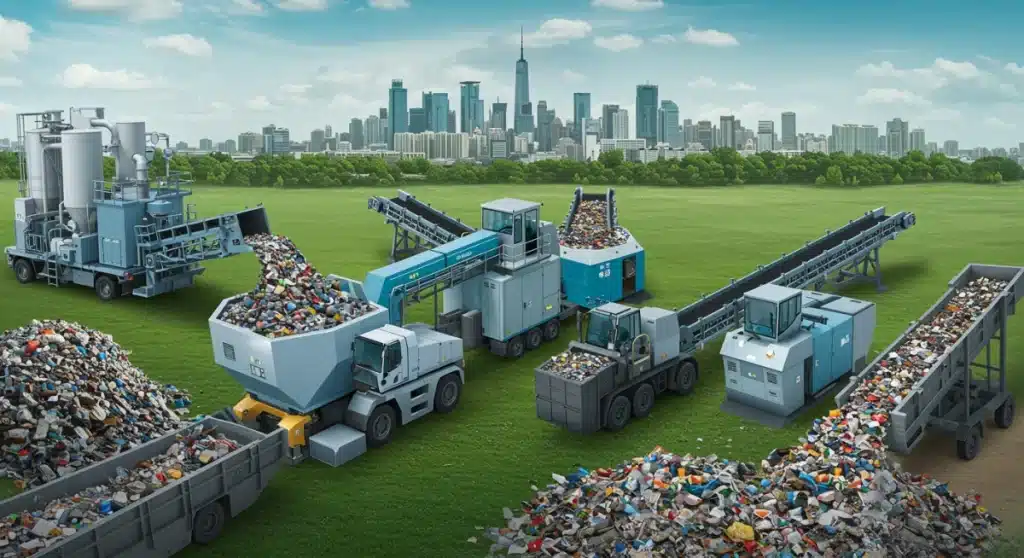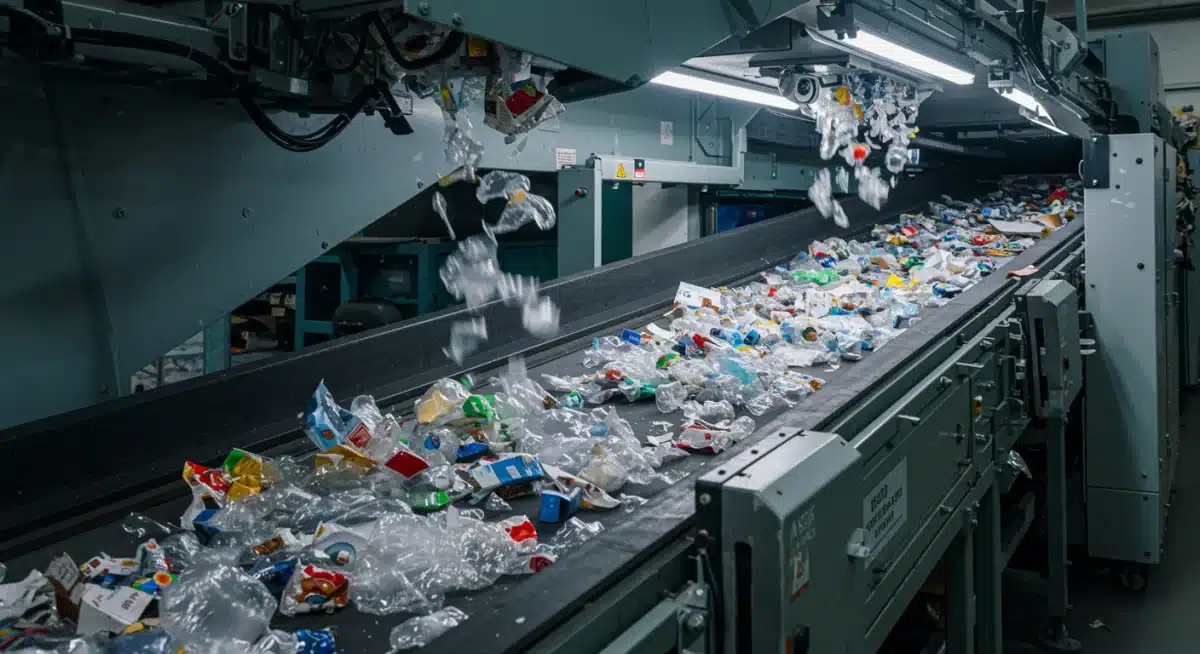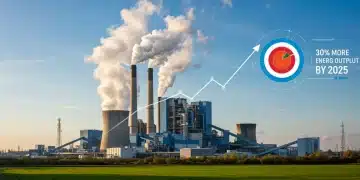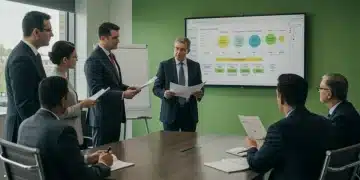Innovative Recycling Tech: Diverting US Landfill Waste by 2025

As of this week, new projections indicate that innovative recycling technologies are poised to divert an additional 20% of U.S. landfill waste by 2025, marking a significant leap toward national sustainability goals.
The Urgent Need for Advanced Waste Diversion
The United States faces an escalating waste crisis, with landfills rapidly filling and environmental concerns mounting. Traditional recycling methods, while vital, often fall short in processing complex waste streams and achieving high diversion rates. This urgent situation necessitates a paradigm shift towards more sophisticated and efficient solutions.
Recent reports from the Environmental Protection Agency (EPA) highlight that despite ongoing efforts, a substantial portion of recyclable materials still ends up in landfills. This not only squanders valuable resources but also contributes to greenhouse gas emissions and environmental degradation. The pressure is on for municipalities and industries to adopt cutting-edge approaches to waste management.
Addressing Landfill Overload
Landfill capacity is a growing concern across many states. Communities are grappling with the environmental and economic costs associated with expanding existing sites or developing new ones. Diverting a significant percentage of waste from these facilities is crucial for long-term urban planning and ecological preservation.
- Resource Scarcity: Landfilling materials like plastics, metals, and organic waste means losing potential raw materials that could be reintegrated into the production cycle, reducing reliance on virgin resources.
- Environmental Impact: Decomposing waste in landfills produces methane, a potent greenhouse gas, and leachate, which can contaminate soil and groundwater. Reducing landfill volume directly mitigates these hazards.
- Economic Burden: The costs associated with landfill operations, including transportation, maintenance, and environmental monitoring, are substantial. Increased diversion can lead to significant cost savings for local governments.
Breakthroughs in Recycling Technology
The landscape of waste management is being revolutionized by several groundbreaking technologies. These innovations are designed to tackle previously unrecyclable materials, increase processing efficiency, and create higher-value end products from waste streams. These advancements are key to achieving ambitious diversion targets.
From advanced sorting systems to chemical conversion processes, the breadth of new solutions is expanding rapidly. Industry leaders and research institutions are collaborating to bring these technologies to market, promising a significant uplift in overall recycling capabilities.
AI-Powered Sorting Systems
Artificial intelligence and robotics are transforming material recovery facilities (MRFs). These systems can identify and separate various materials with unprecedented accuracy and speed, far surpassing human capabilities. This precision is vital for handling mixed waste streams and ensuring clean input for subsequent recycling processes.
- Enhanced Accuracy: AI algorithms can distinguish between different types of plastics, papers, and metals, even those with similar appearances, minimizing contamination.
- Increased Throughput: Robotic arms operate continuously at high speeds, significantly boosting the volume of materials processed daily.
- Cost Reduction: Automation reduces labor costs and improves efficiency, making recycling operations more economically viable.
Chemical Recycling: A Game Changer
Chemical recycling, also known as advanced recycling, is emerging as a critical solution for plastics that cannot be mechanically recycled. This process breaks down polymers into their original molecular components, which can then be used to create new, virgin-quality plastics. This technology holds immense potential for closing the loop on plastic waste.
Several companies are investing heavily in this sector, with new facilities coming online that can process a wide range of plastic waste, including films, multi-layer packaging, and contaminated materials. This represents a significant shift from traditional mechanical recycling, which often struggles with these complex materials.
Depolymerization and Pyrolysis
Two primary methods dominate chemical recycling: depolymerization and pyrolysis. Depolymerization reverses the polymerization process, yielding monomers that are identical to those produced from fossil fuels. Pyrolysis, on the other hand, uses heat in the absence of oxygen to break down plastics into oils, waxes, and gases, which can then be refined into new chemical feedstocks.
These processes offer a pathway to circularity for plastics, reducing the need for virgin plastic production and mitigating plastic pollution. The output from chemical recycling can be used in high-value applications, ensuring that plastic materials retain their economic utility.

Organic Waste Conversion and Biorefineries
Organic waste, including food scraps and yard waste, constitutes a significant portion of landfill content. Innovative technologies are transforming this waste into valuable resources, such as compost, biogas, and biochemicals. These processes not only divert waste but also contribute to renewable energy generation and soil health.
Biorefineries are at the forefront of this movement, integrating various biotechnological processes to convert organic feedstocks into a diverse portfolio of bio-based products. This holistic approach maximizes resource recovery and minimizes environmental impact.
Anaerobic Digestion and Composting
Anaerobic digestion facilities break down organic matter in the absence of oxygen, producing biogas (a mixture of methane and carbon dioxide) that can be used for energy. The digestate remaining after the process is a nutrient-rich material that can be used as fertilizer. Composting, another established method, converts organic waste into nutrient-rich soil amendments.
- Energy Generation: Biogas can power homes and vehicles, reducing reliance on fossil fuels.
- Soil Enrichment: Compost and digestate improve soil structure, water retention, and nutrient content, supporting sustainable agriculture.
- Waste Volume Reduction: Both processes significantly reduce the volume of organic waste sent to landfills.
Policy and Investment Driving Change
The push for increased recycling diversion is not solely driven by technological innovation; supportive policy frameworks and substantial investments are equally crucial. Governments at federal, state, and local levels are implementing initiatives to incentivize recycling, promote circular economy principles, and fund research and development in green technologies.
Private sector investment is also surging, as companies recognize the economic opportunities in waste-to-value solutions and seek to enhance their environmental, social, and governance (ESG) performance. This convergence of public and private efforts is accelerating the adoption of new recycling methods.
Federal and State Initiatives
Recent federal legislation and state-level mandates are setting ambitious recycling targets and providing grants for infrastructure development. These policies create a favorable environment for the deployment of innovative recycling technologies and encourage businesses to integrate sustainable practices into their operations.
For example, several states have enacted extended producer responsibility (EPR) laws, which hold manufacturers accountable for the entire lifecycle of their products, including their end-of-life management. This incentivizes product design for recyclability and invests in recycling infrastructure.
The Role of Consumer Participation and Education
While technology and policy are foundational, successful waste diversion ultimately depends on robust consumer participation and effective public education. Misinformation and confusion about what can and cannot be recycled remain significant barriers to maximizing recycling rates. Clear, consistent messaging is vital.
Educational campaigns need to simplify recycling guidelines, highlight the benefits of proper waste separation, and showcase the positive impacts of collective action. Engaging communities in these efforts is paramount for achieving the 2025 landfill diversion target.
Simplifying Recycling Guidelines
Many consumers are overwhelmed by complex recycling rules that vary by municipality. Standardizing guidelines where possible and providing easily accessible information can significantly improve participation rates. Clear labeling on products also plays a crucial role in informing consumers.
- Digital Tools: Mobile apps and online resources can help residents quickly identify what is recyclable in their area and where to dispose of specific items.
- Community Programs: Local workshops, school programs, and public awareness campaigns can foster a culture of recycling and environmental stewardship.
- Feedback Mechanisms: Providing feedback to residents on the impact of their recycling efforts can reinforce positive behaviors and encourage continued participation.
| Key Aspect | Brief Description |
|---|---|
| Waste Diversion Goal | Targeting 20% more U.S. landfill waste diverted by 2025 through green solutions. |
| Key Technologies | AI-powered sorting, chemical recycling, and organic waste conversion are central to progress. |
| Driving Forces | Policy support, private investment, and consumer education are accelerating adoption. |
| Environmental Impact | Reduces greenhouse gas emissions, conserves natural resources, and mitigates pollution. |
Frequently Asked Questions About Recycling Innovation
Innovative recycling technologies encompass advanced methods like AI-powered sorting, chemical recycling for plastics, and sophisticated organic waste conversion processes. These solutions aim to increase efficiency, handle complex waste streams, and create higher-value products from materials traditionally sent to landfills.
By processing materials previously deemed unrecyclable and improving the speed and accuracy of sorting, these technologies will significantly expand the range of recoverable waste. This enhanced capability is projected to increase overall diversion rates, supporting the target of 20% more U.S. landfill waste diverted by 2025.
Chemical recycling breaks down plastics into their basic molecular components, allowing them to be remanufactured into new, high-quality materials. It is crucial because it can process mixed and contaminated plastics that mechanical recycling cannot handle, offering a vital pathway to true plastic circularity and reducing reliance on virgin fossil fuels.
Effective waste diversion requires a multi-faceted approach. This includes strong policy support, such as extended producer responsibility laws, and significant public and private investment in infrastructure. Crucially, it also depends on high levels of consumer participation, driven by clear education and simplified recycling guidelines.
Individuals can contribute by diligently sorting their waste according to local guidelines, reducing consumption, and reusing items when possible. Staying informed about local recycling programs and advocating for stronger waste management policies also plays a significant role in supporting the broader shift towards a circular economy.
What Happens Next
The push for diverting 20% more U.S. landfill waste by 2025 is gaining momentum, with legislative bodies and industry leaders closely monitoring progress. We expect to see further policy announcements aimed at fostering green infrastructure and incentivizing the adoption of circular economy models. The coming months will be critical for the deployment of new chemical recycling plants and the scaling of AI-powered sorting systems, which are central to achieving these ambitious targets. Stakeholders anticipate ongoing collaboration between government, private industry, and research sectors to overcome implementation challenges and ensure sustainable waste management for future generations. Watch for updated reports from the EPA and industry consortia detailing the impact of these developments.





